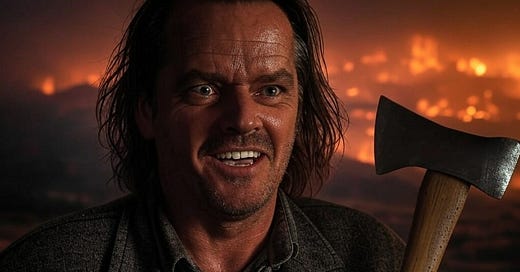From Bombshell to “Dishrag”: Why Stanley Kubrick Cast Shelley Duvall as Wendy in The Shining
Adventures in the film, "The Shining."
From Bombshell to “Dishrag”: Why Stanley Kubrick Cast Shelley Duvall as Wendy in The Shining
Ah, The Shining: a labyrinth of terror, snow, and deeply unsettling family dynamics. One of the most surprising creative choices in Stanley Kubrick’s adaptation was casting Shelley Duvall as Wendy Torrance, a decision that Stephen King famously despised. Wendy in the novel was described as a blonde bombshell, a far cry from the timid, wide-eyed, and somewhat awkward portrayal by Duvall. But why did Kubrick swap out King’s vision of a Hollywood archetype for the quirky charm of Shelley Duvall? What does this change reveal about both creators—and perhaps about King’s own unspoken fantasies? Let’s dive in, because it’s both hilarious and revealing.
The Stephen King Fantasy: Wendy as the Bombshell
In King’s novel, Wendy Torrance is described as a busty blonde beauty—think ’70s Playboy centerfold, but with a heart of gold and a willingness to stick it out with an alcoholic husband at a haunted hotel. It’s no secret that King has a knack for writing “idealized” women, who are often a mix of supportive partner and unattainable fantasy.
But here’s the kicker: Wendy as described in the book doesn’t sound much like Tabitha King, Stephen’s wife, who is neither a blonde nor a bombshell. So why did King create this version of Wendy? Let’s speculate wildly, shall we?
Mid-20th Century Male Fantasy Syndrome: King was a young, rising writer when he penned The Shining. Perhaps his vision of Wendy as a buxom blonde was less about creating a believable character and more about indulging a culturally conditioned fantasy. Who wouldn’t want to spend months snowed in with a supermodel, ghosts be damned?
A Twist of Guilt: Could Wendy’s perfection have been King’s way of compensating for any guilty thoughts about infidelity? By creating an impossibly idealized version of his protagonist’s wife, perhaps he was, ironically, putting his own conscience on trial.
Symbolism or Stereotypes? A bombshell Wendy might have been meant to highlight Jack’s insecurities. After all, what better way to show a man unraveling than pairing him with a partner he feels unworthy of?
Kubrick’s Wendy: The Anti-Bombshell Choice
Enter Stanley Kubrick, a director with little regard for traditional archetypes. His Wendy is no sultry blonde goddess but a fragile, anxious, and arguably goofy woman played by Shelley Duvall. This decision feels deliberate, even defiant—a rejection of King’s idealized Wendy in favor of someone far more human and relatable.
But why?
The Power of Powerlessness: Duvall’s Wendy embodies vulnerability, which heightens the horror. She isn’t the confident, sexy partner King envisioned; she’s a woman out of her depth, flailing as her world falls apart. A bombshell Wendy would have felt more capable, less scared—and therefore less effective as a character.
Jack’s Madness Feels Bigger: With Duvall’s Wendy, Jack’s rage and control issues loom larger. She’s not the powerful partner who could match or defy him; she’s someone he can intimidate, making his descent into violence even more terrifying.
Kubrick’s Aesthetic Contrarianism: Let’s face it, Kubrick liked to mess with expectations. Casting Duvall was probably his way of saying, “I’m not here to make a slasher film with a screaming blonde. I’m here to make art.”
Stephen King’s Criticism: The “Dishrag” Defense
King infamously criticized Kubrick’s Wendy as a “screaming dishrag,” a comment that reveals more about him than it does about Duvall’s performance. In King’s mind, Wendy should have been a stronger counterpoint to Jack—a blonde bombshell with backbone. But that critique ignores the nuances of Kubrick’s vision.
In Kubrick’s world, Wendy is meant to crumble, to be overpowered, to barely hold it together. The horror of her situation isn’t just in the ghosts or Jack’s axe-wielding—it’s in the reality of a woman completely unequipped to fight back.
King’s idealized Wendy would have been a different story: a heroine fighting tooth and nail, more Final Girl than frazzled mom. Duvall’s Wendy, by contrast, is a portrait of raw fear—a more haunting and, frankly, relatable portrayal for many viewers.
The Hidden Subtext: King’s Wendy and the Overlook Hotel
Let’s go full armchair psychologist here: Could King’s idealized Wendy represent a subconscious fantasy tied to the Overlook Hotel itself? A remote, lavish place where a struggling writer and his perfect wife are trapped together? The hotel is seductive, promising Jack a better life if he just sacrifices the people he loves. Maybe Wendy as a blonde bombshell wasn’t just about beauty—it was about the temptation to trade in reality for a fantasy, a theme that mirrors Jack’s descent into madness.
Meanwhile, Kubrick flips the script. His Wendy isn’t a seductive fantasy; she’s reality itself—messy, imperfect, and harder to escape. It’s no wonder Jack loses his mind.
Conclusion: Bombshell vs. Dishrag
Stephen King may have dreamed of a blonde bombshell battling ghosts in The Shining, but Stanley Kubrick knew better. By casting Shelley Duvall, he created a Wendy who was raw, real, and, yes, messy. This wasn’t a glamorous horror story; it was a nightmare grounded in human frailty.
So, why did King write his Wendy as a busty blonde? Maybe he was indulging a fantasy. Or maybe he was just trying to create a character that made Jack’s failure seem more pathetic. But Kubrick’s Wendy reminds us that real horror doesn’t come from ghosts or ghouls—it comes from watching someone who’s barely hanging on face unimaginable terror.
Because it was possible, it was necessary, Kubrick gave us Shelley Duvall’s Wendy—a “dishrag” with more grit, fear, and humanity than any bombshell could muster.




